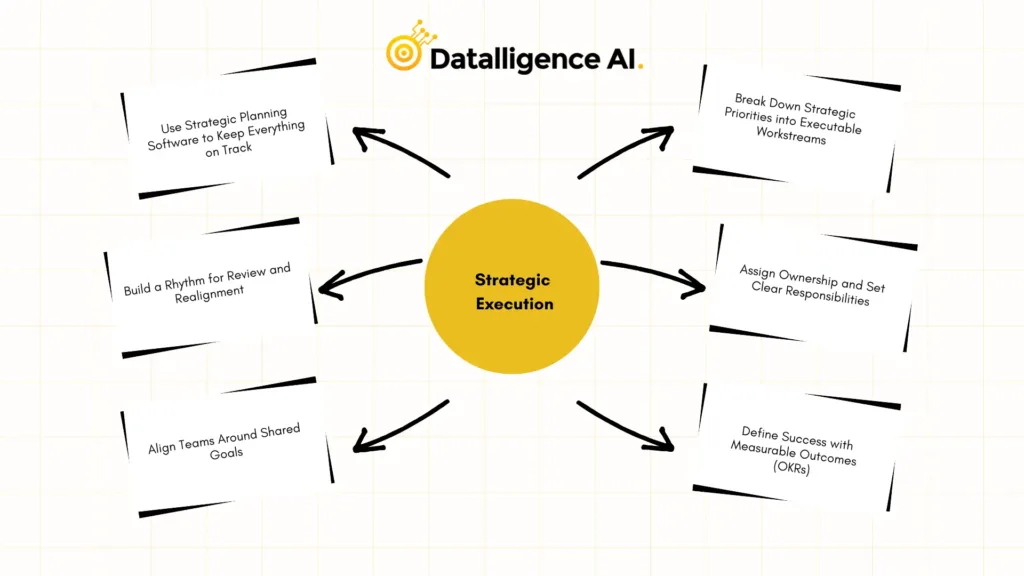In the fast-paced world of business today, growth isn’t just a nice-to-haveit’s a must. However, many organizations find it tough to turn their aspirations into reality due to a lack of structured strategic planning. Without a clear plan in place, even the most ambitious goals can falter, resulting in wasted resources and missed chances. To drive sustainable growth, businesses need to adopt a strategy planning approach that aligns teams, directs execution, and transforms long-term visions into tangible results.
Why Strategy Planning Is the First Step Toward Growth
Strategy planning is the bedrock of any thriving organization. It charts the course for where the business is headed and lays out the steps to get there, helping leaders prioritize initiatives and allocate resources wisely. When leaders engage in strategic planning, they create a clear path that unites teams and sharpens their focus. This clarity is especially vital when navigating changes or reacting to market fluctuations. Companies that take strategy planning seriously can avoid misalignment and ensure that every action contributes to the overall vision.
How to Understand Where Your Business Stands Before Planning
Before you can create a roadmap for growth, it’s essential to grasp your current situation. A comprehensive market analysis can highlight customer pain points and reveal competitive gaps, while a thorough internal assessment can uncover strengths, weaknesses, and areas for improvement. Grounding your planning process in a well-defined vision and mission keeps your strategy focused and purposeful. This strategic context empowers you to make informed decisions and prioritize what truly matters.
What Turns Strategy Planning Into Successful Execution
After assessing your business landscape, it’s time to shift gears from planning to execution. Strategy implementation should flow seamlessly from your planning process. Businesses make a real impact when they concentrate on a few high-leverage priorities and rally their teams around them. This could involve entering new markets, boosting operational efficiency, or enhancing the customer experience.
Once you’ve taken a good look at your business landscape and charted a strategic course, the real work begins: making those plans a reality. Implementing your strategy should feel like a natural extension of your planning process. It’s not just about pinpointing priorities; it’s about bringing them to life throughout the organization.
Here’s how to make that happen
Break Down Strategic Priorities into Executable Workstreams
Start by turning those high-level priorities into actionable workstreams or initiatives. For instance, if your aim is to break into a new market, outline the specific steps you need to takelike conducting market research, setting up a sales team, launching localized marketing campaigns, and establishing customer onboarding processes.
Assign Ownership and Set Clear Responsibilities
Make it clear who’s responsible for what. Each initiative should have a dedicated owner who’s accountable for pushing it forward. When everyone understands their role, execution becomes smoother, and momentum builds more quickly.
Define Success with Measurable Outcomes (OKRs)
Leverage the OKR framework to turn strategy into action. Objectives outline what you want to achieve, while Key Results detail how you’ll measure success. This approach brings focus, clarity, and a sense of urgency to every strategic initiative.
Align Teams Around Shared Goals
Cascading OKRs or SMART goals ensures that departments and individuals are all aiming for the same outcomes. When goals are aligned across the organization, teams collaborate more effectively, resolve conflicts more swiftly, and operate more efficiently.
Build a Rhythm for Review and Realignment
Execution isn’t a “set it and forget it” affair. Schedule regular check-ins to monitor progress, review metrics, and adjust plans as necessary. These touchpoints keep everyone on the same page and ensure you’re responding in real time to what’s workingand what isn’t.
Use Strategic Planning Software to Keep Everything on Track
Modern tools can simplify this entire process. From assigning ownership to tracking progress and adjusting timelines, strategic planning software helps keep everything organized and moving forward.

How to Align Teams for Strategic Execution: A Real-World Look
Picture this: You’ve just finished a quarterly strategy planning session. The leadership team is buzzing with energy, new goals are laid out, and a slide deck has been sent to every team member. But fast forward two weeks, and execution is already starting to falter. Teams are left scratching their heads about how their work fits into the grand scheme. Meetings are happening, but progress feels murky. Morale takes a hit.
Sound familiar?
This scenario often unfolds when strategy planning is confined to the leadership level and fails to resonate with those who are actually putting it into action.
The real shift occurs when you make a concerted effort to align your teams with the strategy. This means moving past one-way communication and weaving strategy into the fabric of daily operations.
Take, for instance, a SaaS company that’s rolling out a new growth strategy aimed at expanding into North America. The executive team has set an ambitious goalto become one of the top three performance management platforms in the region. But the real magic happens when that vision becomes tangible for the folks on the ground.
Here’s how alignment unfolds:
- The sales team establishes weekly KPIs to build a robust enterprise pipeline.
- Marketing kicks off region-specific campaigns to enhance visibility.
- Product accelerates the delivery of features tailored to meet local market demands.
- Every team understands how their efforts contribute to the larger goaland they’re not just checking off tasks; they’re actively shaping the strategy.
To make this alignment a reality, leaders need to:
- Clearly articulate why the strategy is important.
- Break down objectives into smaller, team- and role-specific goals.
- Foster cross-functional collaborationbecause strategy thrives at the intersections.
When teams feel a connection to the company’s mission, they take ownership. They become more motivated and tackle challenges head-on. And that’s what propels execution beyond just ideas on a whiteboard.
How to Track Progress and Stay Agile Mid-Execution
Imagine your strategy is already in action. Everyone’s on board and ready to go. But just a few weeks in, you hit some unexpected bumpsmaybe performance isn’t where it should be, or a competitor rolls out a shiny new feature. Do you stick to your original plan like glue, or do you pivot?
The most successful teams weave agility into their strategy execution.
Take, for example, a fast-growing healthtech startup. Their leadership team meets every two weeks for OKR reviews. During one of these sessions, they notice that a crucial marketing campaign isn’t performing well in a new region. Instead of charging ahead without a second thought, they take a step back, reassess their messaging based on user feedback, and shift their budget toward segments that are more engaged.
This kind of nimbleness is only achievable when:
- You’re consistently tracking progress with dashboards or KPIs.
- Regular check-ins are part of your culture, not just an afterthought.
- Feedback is valuedit’s gathered, discussed, and acted upon.
Rather than shying away from change, agile teams embrace it. They view strategy not as a fixed document, but as a dynamic process that grows and adapts with new insights.
What Strategy in Action Really Looks Like?
Let’s circle back to that SaaS company aiming for growth in North America. Here’s how their strategic planning translated into real, measurable progress:
Objective: Become one of the top three performance management tools in North America.
Key Results:
– Sign 50 enterprise customers within a year.
– Achieve a Net Promoter Score (NPS) of over 60.
– Boost North American website traffic by 40%.
– Roll out a localized marketing campaign by Q3.
By using strategic planning software, they brought their marketing, sales, and product teams together around these key results. They monitored their progress weekly through dashboards, held monthly OKR reviews, and quickly addressed any dips in conversion rates or customer feedback that highlighted missing features.
This clarity kept everyone aligned and allowed them to adjust their course without losing momentum.
Common Strategy Planning Pitfalls (and How to Avoid Them)
Even the most well-intentioned strategies can go off course. One consumer goods company made the mistake of setting 12 “top priorities” for the year. The result? Confusion, diluted focus, and zero standout wins.
Here’s what usually gets in the wayand what to do instead:
Pitfall | What to Do Instead |
Setting too many priorities | Focus on 3–5 high-impact strategic objectives |
Vague, aspirational goals | Make them SMART: Specific, Measurable, etc. |
No alignment across teams | Cascade goals and foster cross-functional syncs |
Ignoring ground-level feedback | Set up open feedback loops across departments |
Losing sight of progress | Use tools that track KPIs in real time |
When companies invest in strategic planning software, they avoid many of these issues. These platforms provide real-time visibility, automated reminders, and seamless team alignment especially vital when goals span multiple departments or geographies.
How Technology Makes Strategy Execution Seamless
As companies grow, executing strategies can get more complicated. Without the right tools, strategic planning can easily get buried in spreadsheets or static PowerPoint presentations.
That’s where strategic planning software comes in and changes the game. It acts as the central nervous system for execution, providing features like:
– Goal-setting frameworks such as OKRs and SMART goals
– Real-time dashboards and performance alerts
– Integrated feedback channels and collaboration tools
– Role-based access so every team can see what’s relevant to them
This level of visibility fosters accountability and cuts down on time wasted chasing updates or misinterpreting priorities. When paired with regular reviews and strong leadership support, strategy evolves into a dynamic part of your businessnot just a slide you glance at once a quarter.
Why Leadership Makes or Breaks Strategy Execution
At the core of every successful strategy is leadership that’s presentnot just at the start, but throughout the entire process.
Leaders need to do more than just communicate goals. They must embody commitment, reinforce clarity, and actively engage in reviews and discussions
Conclusion
Strategic planning is truly the backbone of sustainable business growth. When organizations combine thoughtful planning with disciplined execution, they can transform ambitious visions into tangible outcomes. By rallying around clear objectives, utilizing effective frameworks like OKRs and SMART goals, and tapping into strategic planning software, companies can achieve measurable progress and remain adaptable in an ever-changing landscape.
The secret lies in making strategy planning a regular practice rather than a once-a-year task. With clarity, alignment, and consistent execution, your team can navigate complexities, seize new opportunities, and grow with intention.













